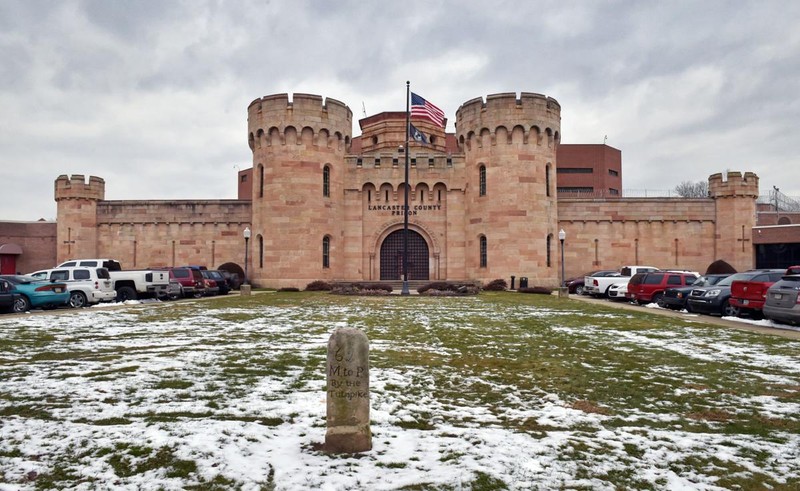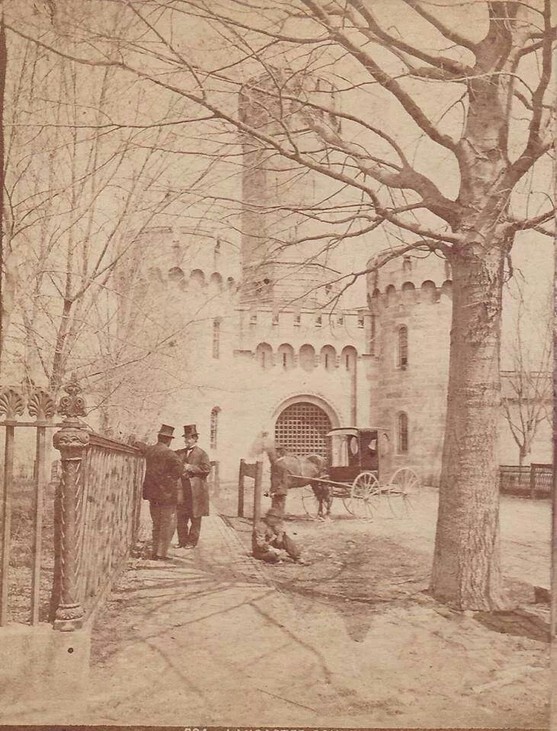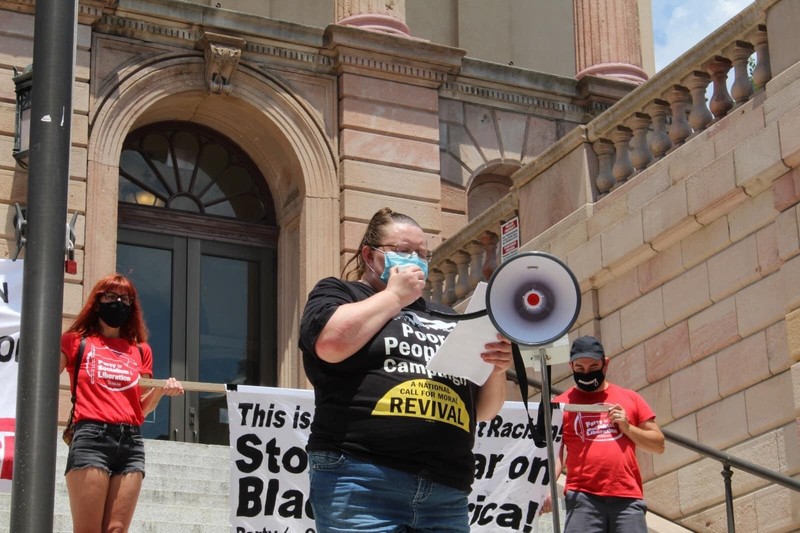Lancaster County Prison
Introduction
Text-to-speech Audio
Images
Lancaster County Prison, built from 1849-1851.

Lancaster County Prison before the iron gates were removed in the 1920s and the 110-foot tower was removed in 1886.

July 5, 2020 protests against inhumane conditions inside the Lancaster County Prison.

Backstory and Context
Text-to-speech Audio
The present Lancaster County Prison in Lancaster, Pennsylvania was constructed in 1849, 15 years after public hangings, which continued until 1912, were moved into the prison for criminals to be executed privately. The first prison was constructed in 1729, when on June 9 of that year, the Lancaster County magistrate met at John Posthlewait’s Tavern in the Conestoga Township to order the construction of a jail. The prison was erected by County Sheriff Robert Barber on his land at Wright’s Ferry, now known as Columbia. The prison, named the “Common Gaol of the County of Lancaster” was constructed of logs, and was completed pending inspection by November 4, 1729. Until the summer of 1775, it remained the only place in the city for incarceration.
In the summer of 1774, construction began on a new, stone jail on the northwest corner of West King (then known as High Street) and North Prince Streets, and was completed by June of 1775. After that jail was in operation for over 50 years, a committee was appointed in 1827 to study the feasibility of creating another new jail, yet submitted an adverse report. In 1831, the insufficiency of the jail was again called into question by a grand jury, which submitted a report to the County Convention at the Lancaster County Courthouse. Another committee was appointed, but again reported it was “inexpedient and unnecessary” to erect a new jail. However, the committee did report that the current prison should be repaired and a yard might be necessary for security and the wellbeing of prisoners. In the summer of 1831, those repairs consisted of raising the jail wall along West King Street four feet.
On January 27, 1849, commissioners and a grand jury made the official decision to build a new prison, which would be on East King Street, then known as the Philadelphia Turnpike. On January 30 of that year, commissioners approved that plan and stipulated that the prison would be constructed by John Haviland from Philadelphia. Land was purchased on East Orange Street from John Duchman for $300 per acre, as well as half of a town lot from Jacob Druckemiller for $130. Additionally, the City of Lancaster deeded a piece of ground to the county on East King Street for a consideration of $500. On February 5, a contract was signed with Haviland for construction, furnishings, and labor of the new prison and accommodations for the keeper and his assistants on the ground for $102,000, which would be completed in two years and six months.
The new prison was constructed of a red (Cocalico) sandstone quarried from the William and Joseph Konigmacher Quarry near Ephrata and was 200 feet long in the front, with the hexagonal area within the walls measuring 500 feet from east to west and a depth of 300 feet from north to south. It was meant to be a similar model to an 18th-century castle in Lancashire, England, and had two 50-foot circular towers in the center and two octagonal towers on the sides, with an arched gateway with large grated iron bars that were lowered by chains at the entryway, as well as a 110-foot polygonal tower that served as an air shaft, which was later dismantled around 1886. Upon completion, the Lancaster County Prison could hold 160 prisoners in 80 cells, with 40 cells on each of the two floors, with ground floor cells containing 33-foot-long exercising areas. Cells had steel grate doors and wooden doors that could be closed for isolation, walls were built to be 18 inches thick for safety, and it originally had an iron fence around the property, which was taken down in the 1920s.The prison also contained its own gas works to manufacture any gas consumed by the institution, making the total cost of construction $110,000.
On September 12, 1851 the first prisoners were moved into the new Lancaster County Prison and on September 15, the final settlement was made with the contractor. P.H. Ehrman and C. Hager bought the former prison property for $8,400. Until 1912, prisoners continued being hanged at the prison. Leading up to 1834, executions were public events, typically held in Gallows Hill, which later became the site of the Fulton Theatre, in Lancaster. The commonwealth’s first recorded public hanging was of Derek Johnson (for murder) on July 9, 1693; however, Lancaster’s first official hanging was of John Jones on June 6, 1759. Pennsylvania became the first U.S. state to outlaw public executions on April 10, 1834, when the city’s executions were moved to the Lancaster County Prison. The practice did not end until nearly 80 years later after an accident on May 23, 1912, when a rope broke during an attempted hanging of Antonio Romezzo inside the prison, and he had to be hanged a second time almost 20 minutes later. In 1913, Pennsylvania moved to electrocution as the uniform method of capital punishment.
An extensive modernization of the prison occurred in 1972. Recent protests have argued that more changes need to be made. On July 5, 2020 the Lancaster Healthcare Right Committee and the Party for Socialism and Liberation held protests to “end cruel conditions in the prison.” Again, on September 17, 2020, representatives from CRASH (Collective Resistance Acting in Solidarity for Humanity) rallied outside the Lancaster County Government Center to demand changes to the prison, protesting cramped and unsafe conditions that led to the deaths of three inmates due to COVID-19, as well as conditions such as a lack of air conditioning during summer months.
Sources
- History of the Lancaster County Prison, County of Lancaster Pennsylvania. Accessed November 10th 2020. https://www.co.lancaster.pa.us/DocumentCenter/View/330/History-of-the-Prison?bidId=.
- Interview: CRASH works for changes at the Lancaster County Prison, Socialist Resurgence. October 1st 2020. Accessed November 10th 2020. https://socialistresurgence.org/2020/10/01/interview-crash-works-for-changes-at-the-lancaster-county-prison/.
- Schazenbach, Emma. “End the Cruel Conditions in Lancaster County Prison”, Put People First PA. July 15th 2020. Accessed November 10th 2020. https://www.putpeoplefirstpa.org/end-the-cruel-conditions-in-lancaster-county-prison/.
- Hang’em High! The macabre history of public hangings in Lancaster, Uncharted Lancaster. October 24th 2019. Accessed November 10th 2020. https://unchartedlancaster.com/2019/10/24/hangem-high-the-macabre-history-of-public-hangings-in-lancaster/.
- Bethke, Robert D.. Pennsylvania Folklife Vol. 20, No. 1. 1970. Ursinus College. Accessed November 10th 2020. https://digitalcommons.ursinus.edu/cgi/viewcontent.cgi?article=1041&context=pafolklifemag.
https://www.google.com/url?sa=i&url=https%3A%2F%2Flancasteronline.com%2Fnews%2Flocal%2Finmates-released-from-lancaster-county-prison-to-reduce-risk-of-spreading-covid-19%2Farticle_f79e098e-7057-11ea-bb26-8b9cf8c45299.html&psig=AOvVaw05qZxZuA35uX4-bLFMqTKt&ust=1605080558632000&source=images&cd=vfe&ved=0CAMQjB1qFwoTCLCM5aK99-wCFQAAAAAdAAAAABAO
https://unchartedlancaster.com/2019/10/24/hangem-high-the-macabre-history-of-public-hangings-in-lancaster/
https://www.putpeoplefirstpa.org/end-the-cruel-conditions-in-lancaster-county-prison/
